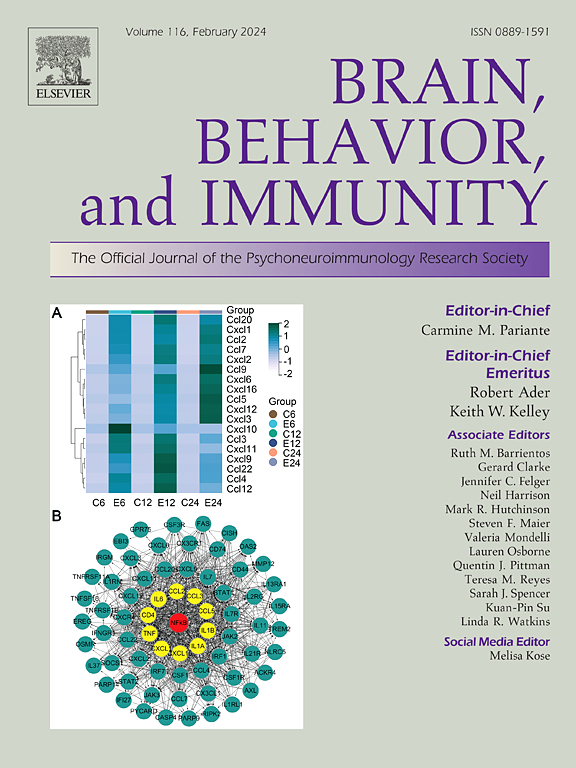原发性感觉神经元衍生的 miR-let-7b 是压力诱发银屑病的基础。
IF 8.8
2区 医学
Q1 IMMUNOLOGY
引用次数: 0
摘要
银屑病是一种慢性自身免疫性皮肤病,全球发病率很高,严重影响患者的生活质量。压力被认为是诱发银屑病的一个重要因素,有效控制压力可以改善银屑病的病理表现。然而,压力影响银屑病的确切机制仍然难以捉摸。本研究发现,与对照组小鼠相比,慢性社会挫败应激(CSDS)小鼠表现出更严重的咪喹莫特(IMQ)诱导的银屑病,表皮鳞屑、表皮增生、表皮脊数量、瘙痒和皮肤炎症均有所增加。机理研究发现,CSDS 会导致 Toll 样受体 7(TLR7)的内源性配体 miR-let-7b 从背根神经节(DRG)神经元的外周末端向皮肤释放。这一过程会刺激皮肤驻留的巨噬细胞释放细胞因子(如 IL-6 和 TNF-a)和趋化因子(如 MCP-1),随后促进更多的巨噬细胞被招募到皮肤中。值得注意的是,特异性阻断 DRG 神经元中的 miR-let-7b,可有效缓解应激诱发的银屑病恶化。此外,皮内注射合成的 miR-let-7b 可诱导野生型小鼠出现类似牛皮癣的表型,而应用 TLR7 拮抗剂可消除这种现象。此外,微流体室共培养试验表明,DRG 神经元释放的 miR-let-7b 可通过这些免疫细胞上表达的 TLR7 激活巨噬细胞。总之,这项研究发现,应激诱导的 DRG 神经元 miR-let-7b 的上调和释放会刺激巨噬细胞分泌更多的炎症细胞因子和趋化因子,从而加剧皮肤炎症和银屑病表型。这些发现提供了一种针对 miR-let-7b/TLR7 通路的潜在治疗策略,以缓解压力引起的银屑病恶化。本文章由计算机程序翻译,如有差异,请以英文原文为准。
Primary sensory neuron-derived miR-let-7b underlies stress-elicited psoriasis
Psoriasis, a chronic autoimmune skin condition with significant global morbidity, badly impairs patients’ quality of life. Stress has been identified as a prominent trigger for psoriasis, and effectively management of stress can ameliorate its pathological manifestations. However, the precise mechanisms by which stress influences psoriasis remain elusive. In this study, we found that mice subjected to chronic social defeat stress (CSDS) exhibit severer imiquimod (IMQ)-induced psoriasis with increased epidermal scaling, epidermal hyperplasia, number of epidermal ridges, itch, and skin inflammation than control mice. Mechanistic study reveals that CSDS leads to an elevated release of miR-let-7b, an endogenous ligand of Toll-like receptor 7 (TLR7), from the peripheral terminal of dorsal root ganglia (DRG) neurons into the skin. This process can stimulate skin-resident macrophages to release cytokines (such as IL-6 and TNF-a) and chemokines (such as MCP-1), subsequently promoting the recruitment of additional macrophages into the skin. Notably, the specific blockade of miR-let-7b in DRG neurons effectively relieve stress-induced exacerbations of psoriasis. Furthermore, intradermal injection of synthetic miR-let-7b can induce a psoriasis-like phenotype in wildtype mice, a phenomenon that can be countered by the application of a TLR7 antagonist. Additionally, microfluidic chamber coculture assays demonstrated that miR-let-7b released by DRG neurons activates macrophages via TLR7 expressed on these immune cells. Totally, this study found that stress-induced upregulation and release of miR-let-7b from DRG neurons stimulates macrophages to secrete more inflammatory cytokines and chemokines, thereby exacerbating skin inflammation and the psoriatic phenotype. These findings provide a potential therapeutic strategy targeting the miR-let-7b/TLR7 pathway to alleviate stress-induced exacerbation of psoriasis.
求助全文
通过发布文献求助,成功后即可免费获取论文全文。
去求助
来源期刊
CiteScore
29.60
自引率
2.00%
发文量
290
审稿时长
28 days
期刊介绍:
Established in 1987, Brain, Behavior, and Immunity proudly serves as the official journal of the Psychoneuroimmunology Research Society (PNIRS). This pioneering journal is dedicated to publishing peer-reviewed basic, experimental, and clinical studies that explore the intricate interactions among behavioral, neural, endocrine, and immune systems in both humans and animals.
As an international and interdisciplinary platform, Brain, Behavior, and Immunity focuses on original research spanning neuroscience, immunology, integrative physiology, behavioral biology, psychiatry, psychology, and clinical medicine. The journal is inclusive of research conducted at various levels, including molecular, cellular, social, and whole organism perspectives. With a commitment to efficiency, the journal facilitates online submission and review, ensuring timely publication of experimental results. Manuscripts typically undergo peer review and are returned to authors within 30 days of submission. It's worth noting that Brain, Behavior, and Immunity, published eight times a year, does not impose submission fees or page charges, fostering an open and accessible platform for scientific discourse.

 求助内容:
求助内容: 应助结果提醒方式:
应助结果提醒方式:


